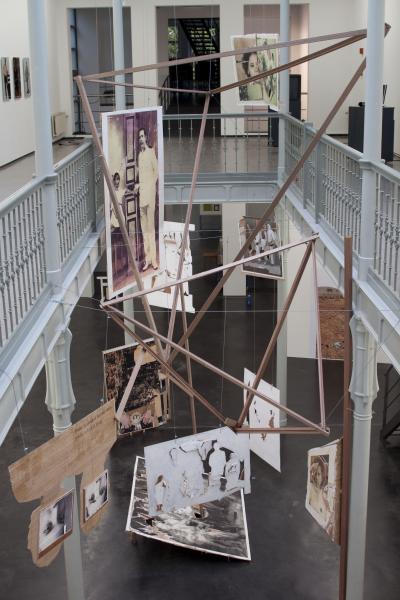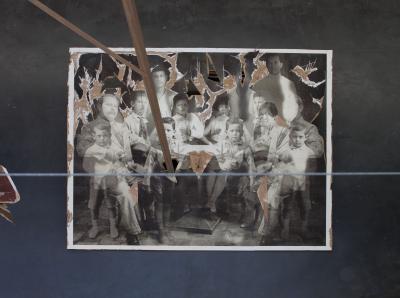Absence and presence: Naro Snackey’s Photographic Sculptures
This installation of photographic sculptures, called Romantic Detachment, was specially developed for UNFIXED, a multiplatform project that explores photography’s relationship to ideas of ethnicity, culture and identity in contemporary art. It was exhibited in the UNFIXED exhibition in the Center for Contemporary Art (CBK) in Dordrecht, The Netherlands in 2010. Much of the artwork of Naro Snackey, who is the maker of the installation, has been drawn from her personal archive and reveals the “social lives” of the family photographs that migrants from mixed descent brought with them from the Netherlands-Indies to the Netherlands during the processes of decolonization. In her work, Snackey often focuses on cultural identity and family background, in Romantic Detachment. She also explores the absence and presence of colonial legacies. As a second generation Indo-Dutch migrant she has always been interested in the extent to which archives determine postcolonial history. Therefore, her photographic image work can be regarded as an exploration of the intermingling of personal and public memories and of how “absent” family histories linger on in the margins of national discourses.
Romantic Detachment reveals how Snackey’s work entails a variety of different forms and techniques. It is not only the interaction between the audience and the installation that produces new dimensions of time and space, but also the artist’s physical way of working and reworking the photographs. The enlarged prints of family photographs, mainly from her own family archive, serve as a first layer in the sculptures, which develop in different stages. Attached to layered plywood, the photographs are given a material “underground body”. The combination of personal photographs and wood is highly deliberate, as both are memories of a past life and both refer to their own past. Whereas the wooden body frames and sustains the photographic images, it also opens up the opportunity to carve into the layers underneath the surface. By scratching, tearing, painting, cutting, digging and carving with a chisel Snackey turns the wood into a sculpture whilst still keeping the photographic image recognizable. Through this process of obsessive carving, the object suggests new spaces of meaning, which invites the viewer to look beyond representation and the obvious image content.
I see Snackey’s work as an intervention in traditions of looking, as an undermining of the one-dimensional nostalgic force of faded colonial pictures. It reveals the many layers and lives of a photograph, so that in the end her sculptured photographic objects serve as a platform for the variety of meanings and histories at play in the images.
The construction of a fragile installation in which the photographic sculptures take their place is a next step in Snackey’s working process. By responding to a specific space, Romantic Detachment addresses the viewers’s senses and works through bodily experiences of moving around, listening to, touching and looking at the installation with its photographic sculptures perceptible from all angles. The incorporation of such visual and sensory memorial devices as colonial photographs in the installation forges connections between absence and presence and between present and past. Rather than presenting a linear history of past events, Snackey’s installation consists of incomplete fragments and acts as a network that weaves the hidden past of an Indo-Dutch migrant family into a newly created present in the multicultural Netherlands. Moving around the installation, the audience will be surprised when they see the reverse side of the re-worked objects, which literally makes visible that the photographic image may hide something below its surface.
By creating dynamic bodily experiences, Snackey’s UNFIXED installation suggests that it is not the meaning of colonial family photographs per se that is important but their social effects. The installation of photographic objects also hints that such effects are momentarily fixed only to change again. If we see her photographic objects as active social actors, rather than merely passive entities, then Romantic Detachment can be regarded as an exploration of the continuing trajectory of colonial photographs over time, marked by changes in ownership, physical location and materiality. As its connection to the past is mediated not through recollection but through an imaginative investment and creation, Snackey’s installation shapes what Marian Hirsch has coined “postmemory”. Postmemory is a powerful and particular form of memory created by a second generation who are generationally distanced from lived experiences and from history by deep personal connection. It characterizes the “experiences of those who grow up dominated by narratives that preceded their birth, whose own belated stories are evacuated by the stories of the previous generation shaped by traumatic events that can be neither understood nor recreated”.[i] Ultimately, Romantic Detachment testifies to the way family photographs transcend the boundaries between the personal and the public domain and explore the colonial past as a well-preserved national “family secret”.
Pamela Pattynama
[i] Hirsch, Family Frames, 22

